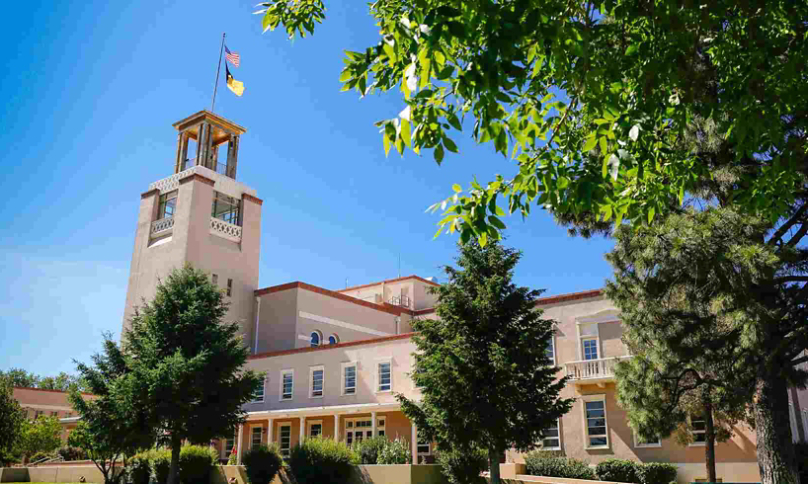
Solutions & InnovationArticle
Sustainability in Action: State of New Mexico Government Buildings
July 07, 2022
How a holistic approach to modernizing buildings helped New Mexico decarbonize aging buildings and reduce energy costs.

Solutions & InnovationArticle
July 07, 2022
How a holistic approach to modernizing buildings helped New Mexico decarbonize aging buildings and reduce energy costs.
We’re helping solve our customers’ big challenges by innovating and delivering solutions that are better for their business - and for the environment.

Project At-a-Glance:
The opportunity: Help New Mexico reach its financial and clean energy goals by modernizing and decarbonizing 32 aging government buildings through its State Buildings Green Energy Project.
The solution: A sustainability makeover—partially funded with future energy savings through a Trane® Energy Savings Performance Contract and utility rebates—includes high-efficiency HVAC systems, rooftop solar panels, LED lighting, water conservation measures and advanced controls to monitor and maximize energy efficiency.
Sustainability outcomes:
New Mexico state facilities and energy management leaders were tasked with figuring out how to modernize aging state-owned buildings in a way that is fiscally sound and environmentally sustainable.
At more than 50 years old, 32 buildings in the historic capital of Santa Fe were uncomfortable for staff and visitors, with inefficient HVAC systems that left them feeling unbearably hot during Southwestern summer heatwaves and cold in the desert winters. What’s more, the unreliable systems demanded costly emergency repairs. At the time, the state already faced more than $300 million in deferred maintenance costs, funded by taxpayers.
Climate change exacerbated the problem. While rich in natural resources, New Mexico—dubbed the Land of Enchantment—has been in a drought for nearly two decades, and upland forests are threatened annually by fires. The Santa Fe campus’s fragile building infrastructure was no match for the pressure of fluctuating temperatures and weather uncertainty.
Trane - by Trane Technologies, a global climate innovator - had already been New Mexico’s HVAC management partner for more than 30 years, and the state chose the business again to be its Energy Savings Performance Contractor (ESPC). In this role, Trane would help to identify the facility improvements needed to modernize, decarbonize and reduce energy costs.
After conducting an investment grade audit, the team worked with the state’s energy engineer to create an energy- and building-efficiency project that would meet each of the Santa Fe facilities’ immediate and long-term building management needs. The extensive audit—reviewing the energy efficiency and renewable energy components in each of the 32 buildings, a scope that normally takes six months to a year—was completed in just 60 days.
And, even though the pandemic caused additional challenges around supply chain, labor and inflation, obstacles, Trane completed the project—the largest renewable energy efficiency project ever undertaken by the state of New Mexico—on time and on budget in 2022.
The project to modernize the existing building systems included an end-to-end holistic approach, customized for each unique building and structure. Among the range of solutions implemented were high-efficiency cooling and heating systems and digital controls, upgrading the building envelopes to reduce energy waste, converting lighting to LED, adding window insulation and installing low-flow fixtures to conserve water.
The more modern system also enables clean, renewable power generation through multiple large-scale rooftop solar photovoltaic installations—the largest solar photovoltaic system not owned by a utility in the state of New Mexico, generating 1.6 megawatts of electricity a year.
Today, New Mexico’s State Buildings Green Energy Project is a leading example for how efficient and healthier buildings can help create communities that are more resilient, prosperous and sustainable—for residents and the environment alike.
Not only are the facilities now safer and more comfortable for visitors and staff members, but the improvements ensure they will stay that way—even in the face of future calamities. If the state loses power during a wildfire, for example, back-up energy supply kicks in, thanks to on-site energy storage.
As a result of the improvements made with Trane, the state is conserving 5.1 million gallons of water and offsetting more than 7,400 metric tons of greenhouse gas emissions annually—the equivalent of eliminating the emissions produced by burning over 8 million pounds of coal.
We want to be wise stewards of taxpayers’ dollars, so a project like this that saves money while saving energy is just a win-win. But I’m also proud of the fact that the building’s going to be a healthier place for my staff and the public who visit us.
Working with Trane, the State of New Mexico has set a new standard for government leaders’ economic stewardship of tax dollars by illustrating how sustainability and cost savings can go hand in hand to benefit local economies. The improvements save taxpayers $1.1 million annually on energy costs.
The State Buildings Green Energy Project has accelerated the State of New Mexico’s clean energy and carbon reduction plans. It also supports the state’s Clean Future Act, which sets milestones for emission reductions, including a 50 percent reduction from 2005 levels by 2030 and achieving net-zero emissions by 2050. The state has also pledged to protect scarce water resources through several programs.
This work aligns with Trane Technologies’ 2030 Sustainability Commitments, including our Gigaton Challenge, which aims to reduce our customers’ carbon emissions by one gigaton—one billion metric tons—by 2030.
Recommended for you
Solutions & Innovation Article
How AI Can Help Dramatically Reduce Energy Demand and EmissionsJanuary 07, 2025
Integrating advanced AI technology in HVAC systems is supercharging what’s possible for reducing built environment emissions.
Solutions & Innovation Article
Innovating for Impact: 19th Asian GamesMay 03, 2024
Trane® provides sustainable and efficient indoor climate solutions for the venues of the 19th Asian Games held in Hangzhou, China.
Solutions & Innovation Article
Innovating for Impact: Thermo King® and RTRApril 30, 2024
Thermo King EMEA delivers on its pledge to provide customers like RTR Holland fully electric, zero direct emission refrigeration solutions for every segment of the cold chain.
Solutions & Innovation Article
Innovating for Impact: Thermo King® hybrid-electric multi-temp trailer debuts in ChicagoApril 26, 2024